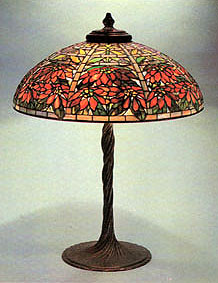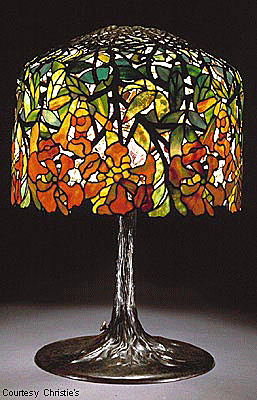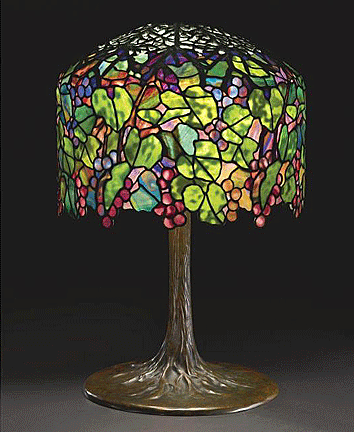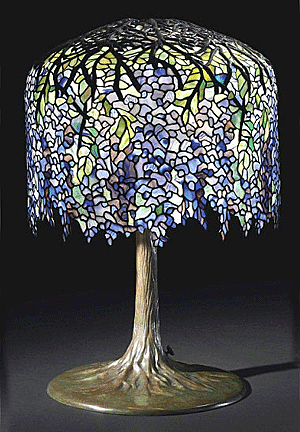|
 "Color
is to the eye as music to the ear," said Louis C. Tiffany, America’s
foremost stained glass designer. He did more to awaken America’s love of
stained glass than any other artist of the 20th century. "Color
is to the eye as music to the ear," said Louis C. Tiffany, America’s
foremost stained glass designer. He did more to awaken America’s love of
stained glass than any other artist of the 20th century.
Louis Comfort Tiffany was considered the leading arbiter of taste in the
Gilded Age, especially among the rich and social elite in America. His
influence wasn’t restricted to glassware, but spread to interior
decoration. He was fortunate to have been living in the age of the light
bulb, developed by fellow American, Thomas Edison, in 1878, and of the
filament lamp which followed in 1879. For it was the marriage of the
electric light with his colorful leaded lampshades that sealed Tiffany's
success.
Louis Comfort Tiffany
Born on February 28, 1848, he was the son of the wealthy Charles Tiffany,
founder of Tiffany & Co. Jewelers, New York. As he grew older, Louis
Tiffany became determined not to follow in his father's footsteps as a
jeweler, and instead chose his own path. After leaving school in 1866 at the
age of eighteen, he began his art studies informally. He became interested
in glass after studying under the great American painter George Inness.
While traveling abroad, he became overwhelmed by the beauty of the stained
glass windows and ceilings in France. He soon discovered that stained glass
had become a neglected art in Northern Europe since the Renaissance. He
realized that this branch of art might offer new fields of challenge in the
United States. It would give him a chance to explore his talent as a
colorist. For Tiffany, color was the most important part of art and the most
essential element in the field of stained glass.
As a young man, Tiffany studied art in Paris. While in France, he met
Emile Galle who was producing art glass in Nancy. Tiffany was, to an extent,
influenced by him, and by the whole awakening Art Nouveau movement. At that
time, however, he wasn’t thinking exclusively of glass but was also
fascinated with Japanese prints, Middle Eastern art, and ancient Roman
pottery.
Upon returning to America, Tiffany continued painting in oils, but he
enlarged his artistic activity to the whole field of decorative arts. He
could have lived on the $35 million he inherited from his father, but he
wanted to make his own mark in the world. So he founded Louis C. Tiffany
& Associated Artists in 1875, and soon employed over one hundred skilled
craftsmen. His interior designs were in great demand, and after restyling a
suite of rooms in the White House in 1883, he became the most fashionable
decorator in New York City.
Tiffany Studios
Tiffany Studios was an independent company formed in the 1890s. Prior to
this, Tiffany had been working as a painter and interior decorator for about
two decades under such names as L. C. Tiffany & Associated Artists, and
Tiffany Glass & Decorating Company. Tiffany's work in art and decorative
arts had led him to design windows and household decorations for special
projects, the manufacture of which was usually contracted out. In the early
1890s, Tiffany decided to concentrate on the large scale production of
stained glass windows, blown glass, lamps, and decorative household items
for retail sale. Stained glass windows were almost always custom designed
for a specific client, and while many of his other decorative items were
stock pieces, some were made as special design orders.
Tiffany's business began to fade just prior to World War I, and in 1917
Tiffany retired while allowing some of his employees to continue to sell
wares as Tiffany Furnaces, though pieces were often made with parts long in
stock that had already been marked Tiffany Studios or L. C. Tiffany. Tiffany
died in 1932, his business bankrupt and liquidated.
He began producing lamps after Thomas Edison suggested the idea during
their collaboration on the electric lighting of the first movie theater, the
Lyceum. But it’s also believed that he began making lamps as a way to use
up scraps from his window manufacturing business. Embracing the Art Nouveau
style at the beginning of the 20th century, he instructed his craftsmen to
create elaborate lamps to fit the new style.
His lamps quickly became popular at home and abroad. Craftsmen set tiny
pieces of glass in natural patterns, featuring flowers, butterflies, or
dragonflies, while the bronze bases complemented the leaded shades. Later,
some shades were made in folds from panels of pressed glass, creating the
appearance of a tweedy fabric. Some of the original Tiffany's were gas,
later converted into electric lighting.
Original Tiffany Lamps
An original Tiffany lamp is one that was created and designed by Tiffany
Studios. As a historical fact, Tiffany never actually made any of the lamps
himself, but just oversaw their production and design. The Tiffany lamps
that came from his studio between 1899-1920 were personally guided by him
through all stages of their creation. This not only included the shades, but
the handmade bronze bases as well.
Tiffany set himself the goal of putting a Tiffany in every household in
America, whether it be his windows, blown glass or his new fashionable table
lamps. The magnificent lamps of Tiffany studios were an instant commercial
success, winning prizes and awards wherever they were displayed.
 He constructed his table lamps in two sections: the base and stem, and
the shade. Shades consisted of many pieces of Favrile glass set in a bronze
framework of irregular shapes, with the decoration often inspired by organic
and naturalistic motifs. Dragonflies were common, as were Renaissance,
zodiacal, bamboo and medieval motifs. Bases, constructed of bronze or gilt
bronze, often incorporated tile or mosaic work. The shade sometimes
reflected the design--the irregular border of lamps like the Apple Blossom
and Wisteria enhanced the organic effect of the tree-like base and floral
motifs. Being hand-made, no two shades were identical. He constructed his table lamps in two sections: the base and stem, and
the shade. Shades consisted of many pieces of Favrile glass set in a bronze
framework of irregular shapes, with the decoration often inspired by organic
and naturalistic motifs. Dragonflies were common, as were Renaissance,
zodiacal, bamboo and medieval motifs. Bases, constructed of bronze or gilt
bronze, often incorporated tile or mosaic work. The shade sometimes
reflected the design--the irregular border of lamps like the Apple Blossom
and Wisteria enhanced the organic effect of the tree-like base and floral
motifs. Being hand-made, no two shades were identical.
Tiffany also developed and used innovative glassmaking methods. He
avoided surface decoration, preferring to make ornament integral to the body
of the piece. However, he was a designer of glassware rather than a
glassmaker and paid little heed to the technical requirements of working in
glass. The craftsmen employed at the factory to produce his designs
frequently found them technically impossible.
At first, Tiffany used glass bought from outside firms, but this did not
give him total satisfaction. The Kokomo Opalescent Glass Company of Kokomo,
Indiana, was one of his suppliers.
Non-colored glass, such as common household window pane, has a natural
tint of green. . This is caused by a small amount of iron oxide present in
sand, a key ingredient of glass. During the Middle Ages, the Venetians
actually developed "decolorizing agents," which neutralized the
iron oxides and removed the green tinge. The result was crystal clear glass,
without the pop-bottle looking green tinge, perfect for use in making art
glass of all kinds. In the case of Kokomo glass, they used many combinations
of coloring agents along with other elements, thus creating specific colors
in the glass.
As his fascination with glass grew, Tiffany experimented with lustering
techniques, largely inspired by the natural iridescence of ancient Roman
glass. He patented his first glass-lustering technique in 1881.And through
much of the 1880's and 1890's, Tiffany experimented with glass, developing
techniques that are still used by the stained glass craft today, such as the
popular "copper-foil" method used in manufacturing his famous
lamps.
Favrile Glass
"Favrile" glass, the type most used in his lamps, resulted from
these experiments. Arthur Nash, the head of Tiffany’s glass team,
suggested the word "Favrile," a modification of the Old English
word "fabrile," meaning "handmade," as a trademark,
registered in 1894, for all Tiffany products. Favrile was simply a
combination of common white glass, call opalescent, used by the early
cosmetics industry to bottle its creams and ointments, and clear colored
glass, called antique, used in stained glass windows for centuries.
Artists, who tried to combine these two glasses before Tiffany, only
produced a dull fragmented material that inhibited the flow of light. But
Tiffany arrived at Favrile through extensive studies in chemistry and
experimentation.
The earliest lamp fixtures weren’t electrified as electricity wasn’t
widely available and incandescent bulbs had not been perfected. Bases for
the lamps, produced elsewhere until the end of the century, were cumbersome
to accommodate a canister for kerosene or gas. Electrified models were
introduced in 1900, but many of these offered a choice of fueling systems
during the transition.
Tiffany added a foundry and metal workshop to his operation in 1898 and
created an array of bronze lamp bases that complemented and enhanced the
designs of corresponding shades. One of his price lists from 1906 lists more
than 300 models for shades and interchangeable bases.
Leaded Shades
While his Favrile shades were free-form and hand-blown, his first leaded
shades were geometric in design. Often, Tiffany craftsmen made these shades
in diochric glass which appeared green in reflected light but orange in
transmitted light.
 He shifted to organic motifs in 1900, when Tiffany introduced the
earliest model of the popular Dragonfly shade at the Paris Exposition. Large
blue-bodied dragonflies with overlapping purple-striated-blue wings were
imposed on a blue-green background mottled with yellow to suggest rippling
water. The wings, themselves, were covered with a metal filigree to simulate
the dragonfly’s veins, and its red eyes, which touched the shade’s lower
edge, or apron, were made of glistening glass jewels. Clara Driscoll, who in
1904 earned a $10,000 annual salary, designed many of these shades. He shifted to organic motifs in 1900, when Tiffany introduced the
earliest model of the popular Dragonfly shade at the Paris Exposition. Large
blue-bodied dragonflies with overlapping purple-striated-blue wings were
imposed on a blue-green background mottled with yellow to suggest rippling
water. The wings, themselves, were covered with a metal filigree to simulate
the dragonfly’s veins, and its red eyes, which touched the shade’s lower
edge, or apron, were made of glistening glass jewels. Clara Driscoll, who in
1904 earned a $10,000 annual salary, designed many of these shades.
Another category of Tiffany lamp was the domed shade, also known as the
flowered cone. Many featured profuse floral patterns of flowers in mottled
colored glass with stems made of granular glass. He also made flowered
globes and shades with irregular lower borders.
Tiffany’s Wisteria lamps fell into the irregular upper and lower
borders category. The multicolored Wisteria shades were remarkable not only
for their superb naturalistic integration of vines and blossoms but as a
complex technical achievement as well. The traditional straight edge of the
opening at the top of the shade was replaced by an openwork crown cast in
bronze which simulated the twisted branches of the vine. Wisteria clusters
terminated in an irregular lower border of unopened blossoms. Each Wisteria
lamp consisted of over a 1,000 pieces of glass. A typical model sold for
$400 in 1906.
Except for special commissions, most Tiffany lamps were made in his
Corona workshops. Once he approved the design, an artist prepared full-scale
drawings. Colorists prepared a chromatic scheme and craftsmen selected and
cut the glass, using a template to guide them. Then they glued thin strips
of copper foil around the edges of the cut pieces, which they placed over
the pattern outlined on a wooden mold. They carefully applied lead and
copper electroplating around the glass pieces, making sure that they rounded
the lines in an organic rather than a flat manner.
 The subject of Tiffany's marks is complex and filled with misconceptions,
elusive to even the seemingly well-informed. Tiffany's marks and marking
systems changed over the years. Some are clear, but others are obscure.
Pieces aren’t always signed or retain their original identification. Some
have had unauthentic markings added. Original Tiffany lamps bear the company’s
name and perhaps a reference number. Some have original paper labels. Shades
were also marked with a bronze pad. The subject of Tiffany's marks is complex and filled with misconceptions,
elusive to even the seemingly well-informed. Tiffany's marks and marking
systems changed over the years. Some are clear, but others are obscure.
Pieces aren’t always signed or retain their original identification. Some
have had unauthentic markings added. Original Tiffany lamps bear the company’s
name and perhaps a reference number. Some have original paper labels. Shades
were also marked with a bronze pad.
"A specific Tiffany signature can usually be found pressed into the
metal rim of the lamp’s shade," said Kim Hewitt, restoration expert
with the Queens Museum of Art, in Corona Park, Queens, New York. "He
sometimes signed his lamps ‘Tiffany and Co.,’ cut from 1900 to 1910, he
usually signed them Tiffany Studios."
According to Alastair Duncan, Tiffany lamp expert and author of a book
about him, the most popular models include the Wisteria, a perennial
favorite, as well as the Peony, another hugely popular model that was in
production from 1904 to the late 1920s. "The Magnolia was considered
the pre-eminent Tiffany lamp some 20-odd years ago," she said. "It’s
a very large floor model. Then we moved to the spiders and the cobweb lamps
with mosaic bases. At the moment, the Lotus has become the most popular, but
there are only three known--two of them are in private collections and one
in a museum."
Tiffany retired in 1918, but he kept a watchful eye on the company. Nash
carried on the business, but his later work, fighting a rearguard action
against Art Deco, wasn’t of the same quality. In 1928, L.C. Tiffany
severed all connection with the firm, withdrawing permission to use his
name.
By his vision and energy, Louis.C. Tiffany succeeded in blending
classical motifs with bold new techniques in glassmaking to create a
distinctive American art form. The demand for Tiffany lamps among today's
collectors attests to the lasting value of his work.
Originally published in AntiqueWeek.
<
Back to
Antiques Articles
Go to the next antiques article >
|
